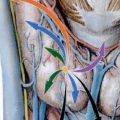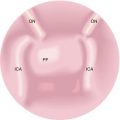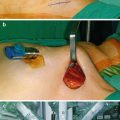John C. Watkinson and David M. Scott-Coombes (eds.)Tips and Tricks in Endocrine Surgery201410.1007/978-1-4471-2146-6_34
© Springer-Verlag London 2014
34. Minimally Invasive Parathyroidectomy
(1)
Department of Thyroid and Endocrine Surgery, Imperial College NHS Trust, Hammersmith Campus, London, UK
Abstract
The operative management of primary hyperparathyroidism has changed significantly since the first parathyroidectomy performed almost a century ago (Delbridge and Palazzo 2007). The standard procedure has evolved over decades into the bilateral neck exploration (BNE) which involves the careful identification of all parathyroid glands. Abnormal glands are removed and the normal glands are left in situ without biopsy.
Abbreviations
BNE
Bilateral neck exploration
FAA
Focused anterior approach
FLA
Focused lateral approach
GA
General anesthesia
IOPTH
Intraoperative PTH
LA
Local anesthesia
MEN
Multiple endocrine neoplasia
MGD
Multiple gland disease
MIP
Minimally invasive parathyroidectomy
MIVAT
Video-assisted parathyroidectomy
NIH
National Institute of Health
PET
Positron emission tomography
pHPT
Primary hyperparathyroidism
PTH
Parathyroid hormone
SCM
Sternocleidomastoid muscle
SPECT
Single-photon emission computed tomography
US
Ultrasound
Introduction
The operative management of primary hyperparathyroidism has changed significantly since the first parathyroidectomy performed almost a century ago (Delbridge and Palazzo 2007). The standard procedure has evolved over decades into the bilateral neck exploration (BNE) which involves the careful identification of all parathyroid glands. Abnormal glands are removed and the normal glands are left in situ without biopsy.
The BNE has the advantage of:
Allowing the direct visualization of all parathyroid glands
Immediate management of all scenarios: double adenomas, hyperplasia, ectopic glands, supernumerary glands, etc.
Minimal morbidity and no mortality
Since over 85 % of pHPT is caused by a single adenoma, the possibility of focusing on the removal of the single abnormal gland and avoiding extra dissection and manipulation of normal parathyroid glands could prevent the risk of complications including hypoparathyroidism, recurrent laryngeal nerve damage, and bleeding. This is the theoretical platform on which focused parathyroid surgery is based.
Focused parathyroid surgery was for many years hindered by the lack of accurate and reliable preoperative localization methods. Neck ultrasonography and technetium-thallium scanning tried to address that problem but the results were patchy. The key breakthroughs in focused parathyroid surgery were:
The arrival of Tc-99 m sestamibi scanning in 1989
Improvements in ultrasound scanning and radiological specialization
The development of intraoperative quick PTH
Assays based on two-site antibody immune-radiometric assay by Nussbaum and the two-site immune-chemiluminometric assay by Brown et al.
The pioneering results obtained with the use of focused unilateral surgery (Sidhu et al. 2003) combined with the use of modern technology resulted in the development of various minimally invasive parathyroidectomy (MIP) techniques:
Focused lateral mini incision
Endoscopic
Radio guided
Video assisted
Robotic
Imaging Studies and Preoperative Localization (See Chap. 32)
MIP requires accurate preoperative localization of the offending gland(s). Traditionally, localization has been done with the use of ultrasound and 99mTc-sestamibi scan. Other methods that can be of value are computer tomography (CT), magnetic resonance imaging (MRI), and 201 T1/99mTc sodium pertechnetate scanning. Other methods such as intravenous jugular sampling are reserved for cases where the other methods are non-corcodant or negative.
Minimally Invasive Parathyroidectomy
Contraindications to All MIP Modalities
1.
History of neck irradiation and prior neck surgery
2.
Concomitant multinodular goiter
3.
Diagnosis of multiple endocrine neoplasia
4.
Proven autoimmune thyroiditis (relative contraindication)
5.
Suspicion of carcinoma
6.
Anatomic considerations such as extreme obesity
MIP Modalities
Focused Lateral Approach (FLA)
The most popular technique worldwide
Can be done under local anesthesia (LA) or general anesthesia (GA)
Technique:
Positioning of the patient:
The same as for any thyroid operation – avoid neck overextension.
A 2 cm incision is made over the anterior border of the sternocleidomastoid muscle (SCM) and the lateral border of the strap muscles (Agarwal et al. 2002).
After dissecting through the subcutaneous fat and platysma, the investing layer of deep cervical fascia is incised.
The strap muscles are retracted to expose the thyroid.
Stay updated, free articles. Join our Telegram channel

Full access? Get Clinical Tree






